The Figures Of The Transparent Bodies
Table of Contents
I will here explain a very easy and natural way of deducing the true shapes which collect or disperse the rays of light by reflection or refraction.
There is not yet the means to use these shapes for Refraction because of:
- the difficulty of shaping the glasses of Telescopes with the needed precision
- refraction itself has a property which hinders the perfect concurrence of the rays
- This was very well proved by Newton by experiment
My invention confirms my Theory of refraction by the agreement between:
- the refracted ray and
- the reflected ray.
Someone in the future will discover utilities in it which are not seen now.
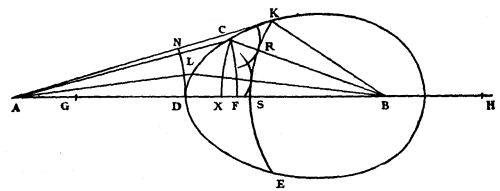
The surface CDE reassembles rays coming from point A at a point B.
- The summit of the surface is the point
Din the straight lineAB.
Whether by reflexion or by refraction, it is only necessary to make
This surface is made so that the light from point A goes to all points of the curved line CDE.
From these, the light goes to the point of concurrence everywhere traversing in equal times.
- As here the path along the straight lines
AC,CB, alongAL,LB, and alongAD,DB
This makes the finding of these curves very easy.
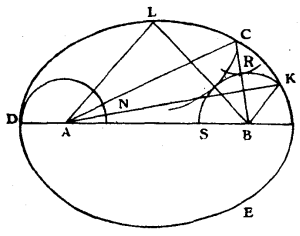
So far as relates to the reflecting surface, the sum of the lines AC, CB should be equal to that of AD, DB.
It appears that DCE should be an ellipse.
For refraction, the ratio of the velocities of waves of light in the media A and B being supposed to be known, for example that of 3 to 2 (which is the same, as we have shown, as the ratio of the Sines in the refraction), it is only necessary to make DH equal to 3/2 of DB.
Having after that described from the centre A some arc FC, cutting DB at F, then describe another from centre B with its semi-diameter BX equal to 2/3 of FH.
The point of intersection of the two arcs will be one of the points required, through which the curve should pass.
For this point, having been found in this fashion, it is easy forthwith to demonstrate that the time along AC, CB, will be equal to the time along AD, DB.
For assuming that the line AD represents the time which the light takes to traverse this same distance AD in air, it is evident that DH, equal to 3/2 of DB, will represent the time of the light along DB in the medium, because it needs here more time in proportion as its speed is slower.
Therefore the whole line AH will represent the time along AD, DB. Similarly the line AC or AF will represent the time along AC; and FH being by construction equal to 3/2 of CB, it will represent the time along CB in the medium; and in consequence the whole line AH will represent also the time along AC, CB. Whence it appears that the [Pg 108]time along AC, CB, is equal to the time along AD, DB.
Similarly it can be shown if L and K are other points in the curve CDE, that the times along AL, LB, and along AK, KB, are always represented by the line AH, and therefore equal to the said time along AD, DB.
In order to show further that the surfaces, which these curves will generate by revolution, will direct all the rays which reach them from the point A in such wise that they tend towards B, let there be supposed a point K in the curve, farther from D than C is, but such that the straight line AK falls from outside upon the curve which serves for the refraction; and from the centre B let the arc KS be described, cutting BD at S, and the straight line CB at R; and from the centre A describe the arc DN meeting AK at N.
Since the sums of the times along AK, KB, and along AC, CB are equal, if from the former sum one deducts the time along KB, and if from the other one deducts the time along RB, there will remain the time along AK as equal to the time along the two parts AC, CR. Consequently in the time that the light has come along AK it will also have come along AC and will in addition have made, in the medium from the centre C, a partial spherical wave, having a semi-diameter equal to CR. And this wave will necessarily touch the circumference KS at R, since CB cuts this circumference at right angles. Similarly, having taken any other point L in the curve, one can show that in the same time as the light passes along AL it will also have come along AL and in addition will have made a partial wave, from the centre L, which will touch the same circumference KS. And so with all other points of the curve CDE.
Then at the moment that the light reaches K the arc KRS will be the termination [Pg 109]of the movement, which has spread from A through DCK.
Thus this same arc will constitute in the medium the propagation of the wave emanating from A; which wave may be represented by the arc DN, or by any other nearer the centre A. But all the pieces of the arc KRS are propagated successively along straight lines which are perpendicular to them, that is to say, which tend to the centre B (for that can be demonstrated in the same way as we have proved above that the pieces of spherical waves are propagated along the straight lines coming from their centre), and these progressions of the pieces of the waves constitute the rays themselves of light.
It appears then that all these rays tend here towards the point B.
One might also determine the point C, and all the others, in this curve which serves for the refraction, by dividing DA at G in such a way that DG is 2/3 of DA, and describing from the centre B any arc CX which cuts BD at N, and another from the centre A with its semi-diameter AF equal to 3/2 of GX; or rather, having described, as before, the arc CX, it is only necessary to make DF equal to 3/2 of DX, and from-the centre A to strike the arc FC; for these two constructions, as may be easily known, come back to the first one which was shown before. And it is manifest by the last method that this curve is the same that Mr. Des Cartes has given in his Geometry, and which he calls the first of his Ovals.
It is only a part of this oval which serves for the refraction, namely, the part DK, ending at K, if AK is the tangent. As to the, other part, Des Cartes has remarked that it could serve for reflexions, if there were some material of a mirror of such a nature that by its [Pg 110]means the force of the rays (or, as we should say, the velocity of the light, which he could not say, since he held that the movement of light was instantaneous) could be augmented in the proportion of 3 to 2. But we have shown that in our way of explaining reflexion, such a thing could not arise from the matter of the mirror, and it is entirely impossible.
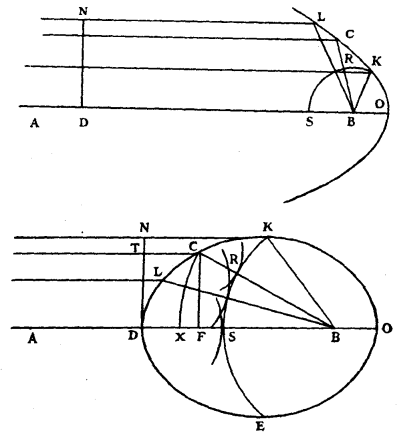
From what has been demonstrated about this oval, it will be easy to find the figure which serves to collect to a point incident parallel rays.
For by supposing just the same construction, but the point A infinitely distant, giving parallel rays, our oval becomes a true Ellipse, the construction of which differs in no way from that of the oval, except that FC, which previously was an arc of a circle, is here a straight line, perpendicular to DB.
For the wave of light DN, being likewise represented by a straight line, it will be seen that all the points of this wave, travelling as far as the surface KD along lines parallel to DB, will advance subsequently towards the point B, and will arrive there at the same time. As for the Ellipse which served for reflexion, it is evident that it will here become a parabola, since its focus A may be regarded as infinitely distant from the other, B, which is here the focus of the parabola, towards which all the reflexions of rays parallel to AB tend. And the demonstration of these effects is just the same as the preceding.
But that this curved line CDE which serves for refraction is an Ellipse, and is such that its major diameter is to the distance between its foci as 3 to 2, which is the proportion of the refraction, can be easily found by the calculus of Algebra.
For DB, which is given, being called a; its undetermined perpendicular DT being called x; and TC y; FB will be a - y; CB will be sqrt(xx + aa - 2ay + yy).
But the nature of the curve is such that 2/3 of TC together with CB is equal to DB, as was stated in the last construction: then the equation will be between (2/3)y + sqrt(xx + aa - 2ay + yy) and a; which being reduced, gives (6/5)ay - yy equal to (9/5)xx; that is to say that having made DO equal to 6/5 of DB, the rectangle DFO is equal to 9/5 of the square on FC.
Whence it is seen that DC is an ellipse, of which the axis DO is to the parameter as 9 to 5.
Therefore the square on DO is to the square of the distance between the foci as 9 to 9 - 5, that is to say 4; and finally the line DO will be to this distance as 3 to 2.
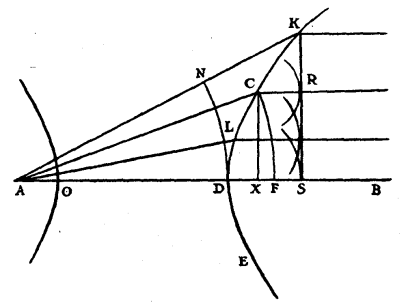
Again, if one supposes the point B to be infinitely distant, in lieu of our first oval we shall find that CDE is a true Hyperbola; which will make those rays become parallel which come from the point A.
In consequence also those which are parallel within the transparent body will be collected outside at the point A.
CX and KS become straight lines perpendicular to BA, because they represent arcs of circles the centre of which is infinitely distant.
The intersection of the perpendicular CX with the arc FC will give the point C, one of those through which the curve ought to pass. And this operates so that all the parts of the wave of light DN, coming to meet the surface KDE, will advance thence along parallels to KS and will arrive at this straight line at the same time; of which the proof is again the same as that which served for the first oval.
Besides one finds by a calculation as easy as the preceding one, that CDE is here a hyperbola of which the axis DO is 4/5 of AD, and the parameter equal to AD. Whence it is easily proved that DO is to the distance between the foci as 3 to 2.
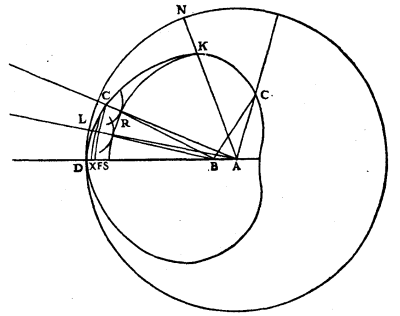
These are the 2 cases in which Conic sections serve for refraction, and are the same which are explained, in his Dioptrique, by Descartes, who first found out the use of these lines in relation to refraction, as also that of the Ovals the first of which we have already set forth.
The second oval is that which serves for rays that tend to a given point; in which oval, if the apex of the surface which receives the rays is D, it will happen that the other apex will be situated between B and A, or beyond A, according as the ratio of AD to DB is given of greater or lesser value.
In this latter case it is the same as that which Des Cartes calls his 3rd oval.
Now the finding and construction of this second oval is [Pg 114]the same as that of the first, and the demonstration of its effect likewise. But it is worthy of remark that in one case this oval becomes a perfect circle, namely when the ratio of AD to DB is the same as the ratio of the refractions, here as 3 to 2, as I observed a long time ago. The 4th oval, serving only for impossible reflexions, there is no need to set it forth.
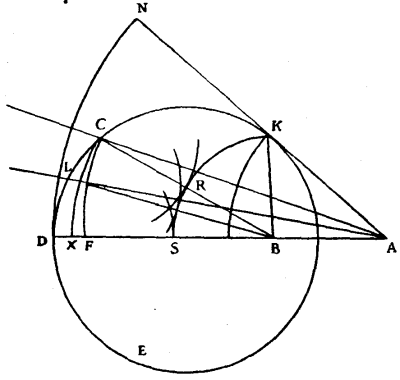
Descartes discovered these lines but has given no explanation of it.
- I do not know anyone else since who can explain it.
The revolution of the curve KDE receives the incident rays coming to it from the point A.
- It deviates them towards point
B
Then considering this other curve as already known, and that its apex D is in the straight line AB, let us divide it up into an infinitude of small pieces by the points G, C, F; and having drawn from each of these points, straight lines towards A to represent the incident rays, and other straight lines towards B, let there also be described with centre A the arcs GL, CM, FN, DO, cutting the rays that come from A at L, M, N, O; and from the points K, G, C, F, let there be described the arcs KQ, GR, CS, FT cutting the rays towards B at Q, R, S, T; and let us suppose that the straight line HKZ cuts the curve at K at right-angles.
Then AK being an incident ray, and KB its refraction within the medium, it needs must be, according to the law of refraction which was known to Descartes, that the sine of the angle ZKA should be to the sine of the angle HKB as 3 to 2, supposing that this is the proportion of the refraction of glass; or rather, that the sine of the angle KGL should have this same ratio to the sine of the angle GKQ, considering KG, GL, KQ as straight lines because of their smallness. But these sines are the lines KL and GQ, if GK is taken as the radius of the circle. Then LK ought to be to GQ as 3 to 2;
In the same ratio MG to CR, NC to FS, OF to DT. Then also the sum of all the antecedents to all the consequents would be as 3 to 2. Now by prolonging the arc DO until it meets AK at X, KX is the sum of the antecedents. And by prolonging the arc KQ till it meets AD at Y, the sum of [Pg 116]the consequents is DY. Then KX ought to be to DY as 3 to 2.
Whence it would appear that the curve KDE was of such a nature that having drawn from some point which had been assumed, such as K, the straight lines KA, KB, the excess by which AK surpasses AD should be to the excess of DB over KB, as 3 to 2. For it can similarly be demonstrated, by taking any other point in the curve, such as G, that the excess of AG over AD, namely VG, is to the excess of BD over DG, namely DP, in this same ratio of 3 to 2. And following this principle Mr. Des Cartes constructed these curves in his Geometric; and he easily recognized that in the case of parallel rays, these curves became Hyperbolas and Ellipses.
Let us now return to our method and let us see how it leads without difficulty to the finding of the curves which one side of the glass requires when the other side is of a given figure; a figure not only plane or spherical, or made by one of the conic sections (which is the restriction with which Descartes proposed this problem, leaving the solution to those who should come after him) but generally any figure whatever: that is to say, one made by the revolution of any given curved line to which one must merely know how to draw straight lines as tangents.
Let the given figure be that made by the revolution of some curve such as AK about the axis AV, and that this side of the glass receives rays coming from the point L. Furthermore, let the thickness AB of the middle of the glass be given, and the point F at which one desires the rays to be all perfectly reunited, whatever be the first refraction occurring at the surface AK.
The sole requirement is that the outline BDK which constitutes the other surface shall be [Pg 117]such that the path of the light from the point L to the surface AK, and from thence to the surface BDK, and from thence to the point F, shall be traversed everywhere in equal times, and in each case in a time equal to that which the light employs, to pass along the straight line LF of which the part AB is within the glass.
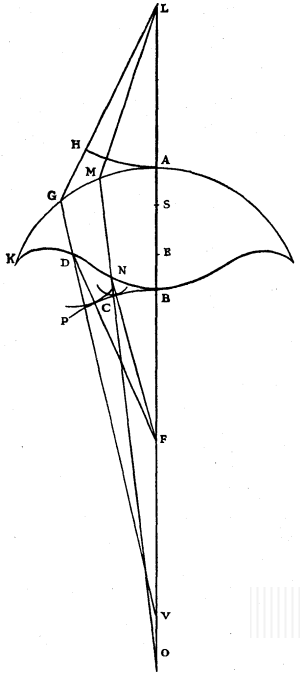
Let:
LGbe a ray falling on the arcAK.
Its refraction GV will be given by means of the tangent which will be drawn at the point G.
Now in GV the point D must be found such that FD together with 3/2 of DG and the straight line [Pg 118]GL, may be equal to FB together with 3/2 of BA and the straight line AL; which, as is clear, make up a given length. Or rather, by deducting from each the length of LG, which is also given, it will merely be needful to adjust FD up to the straight line VG in such a way that FD together with 3/2 of DG is equal to a given straight line, which is a quite easy plane problem:
The point D will be one of those through which the curve BDK ought to pass. And similarly, having drawn another ray LM, and found its refraction MO, the point N will be found in this line, and so on as many times as one desires.